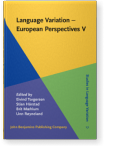A real-time study of plosives in Glaswegian using an automatic measurement algorithm
Change or age-grading?
This paper presents a collaborative study of variation and potential change in the voicing contrast in Scottish English plosives, analyzed in recordings from twelve vernacular female speakers of different generations made in the 1970s and the 2000s in Glasgow. We adapted an existing automatic measurement algorithm for predicting Voice Onset Time (VOT) originally developed for voiceless stops, for the analysis of voiced and voiceless plosives in casual sociolinguistic speech recordings of different kinds. Our semi-automatic method, which involved quick manual coding of automatically-generated positive VOT predictions, resulted in correct or close to correct measures for two-thirds of our data, and allowed us to process a very large number of tokens very quickly, especially for voiceless stops. The VOT results themselves indicate that the voicing contrast is being maintained, but suggest that a change in the phonetic realization of the stops may have been in progress since the middle of the 20th century, specifically a lengthening of aspiration for /p/ and /t/, and a trend to a longer release phase in their voiced counterparts.
References (8)
References
Allen, J. Sean, Joanne L. Miller, and David DeSteno. 2003. “Individual Talker Differences in Voice-Onset-Time.” Journal of the Acoustical Society of America 113: 544–552. 

Cho, Taehong, and Peter Ladefoged. 1999. “Variations and Universals in VOT: Evidence from 18 Languages.” Journal of Phonetics 27: 207–229. 

Docherty, Gerard, Dominic Watt, Carmen Llamas, Damien Hall, and Jennifer Nycz. 2011. “Variation in Voice Onset Time Along the Scottish-English Border.” Paper presented at the ICPhS XVII, Hong Kong.
Johnston, Paul. 1997. “Regional Variation.” In The Edinburgh History of the Scots Language, ed. by Charles Jones. 433–513. Edinburgh: Edinburgh University Press.
Lisker, Leigh, and Arthur S. Abramson. 1967. “Some Effects of Context on Voice Onset Time in English Stops.” Language and Speech 10: 1–28.
Scobbie, James M. 2006. “Flexibility in the Face of Incompatible English VOT Systems.” In Laboratory Phonology. 367–392. Berlin: Mouton de Gruyter.
Sonderegger, Morgan, and Joseph Keshet. 2012. “Automatic Measurement of Voice Onset Time Using Discriminative Structured Prediction.” Journal of the Acoustical Society of America 132: 3965–3979. 

Wells, John C. 1982. Accents of English. Cambridge: Cambridge University Press. 

Cited by (1)
Cited by one other publication
Chodroff, Eleanor & Colin Wilson
2017.
Structure in talker-specific phonetic realization: Covariation of stop consonant VOT in American English.
Journal of Phonetics 61
► pp. 30 ff.

This list is based on CrossRef data as of 24 september 2024. Please note that it may not be complete. Sources presented here have been supplied by the respective publishers.
Any errors therein should be reported to them.
